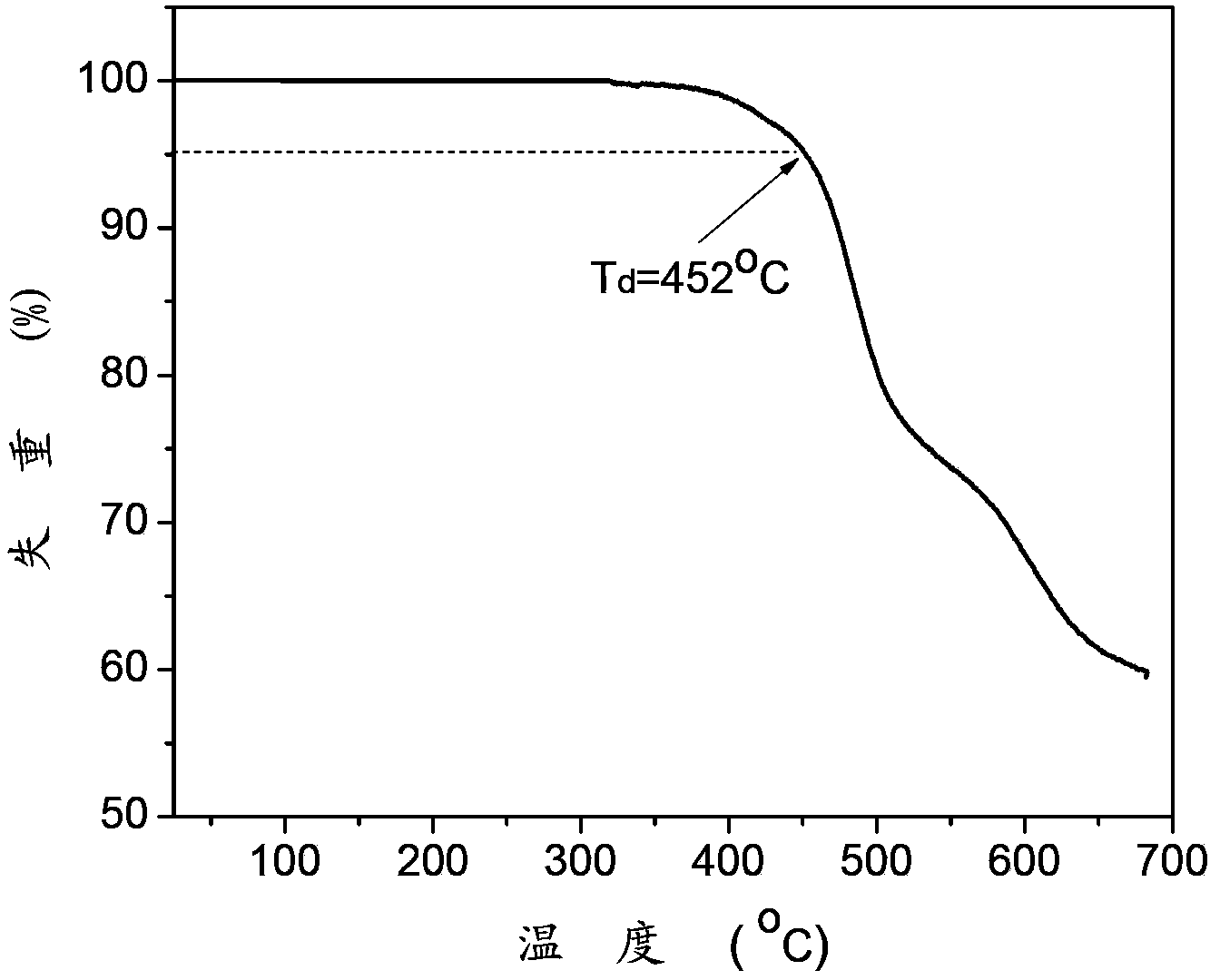Bipolar blue phosphorescent host material, preparation method thereof and organic electroluminescent device
A phosphorescent main body and bipolar technology, which is applied in the manufacture of electric solid-state devices, semiconductor devices, semiconductor/solid-state devices, etc., can solve problems such as shortage, achieve good thermal stability, and improve luminous efficiency.
- Summary
- Abstract
- Description
- Claims
- Application Information
AI Technical Summary
Problems solved by technology
Method used
Image
Examples
Embodiment 1
[0038] Example 1: The bipolar blue phosphorescent host material of this example, namely 9,9'-(4,4'-(2,7-bis(4-(diphenylphosphinothio)phenyl)-9H -Fluorene-9,9-diyl)bis(4,1-phenylene))bis(9H-carbazole), the preparation steps are as follows:
[0039]
[0040] Under argon protection, 9,9'-(4,4'-(2,7-dipinacol borate-9H-fluorene-9,9-diyl)diyl(4,1-phenylene )) bis(9H-carbazole) (180mg, 0.2mmol), (4-bromophenyl) diphenylphosphine sulfur (136mg, 0.4mmol) was added into a flask filled with 10ml of toluene solvent, and after fully dissolving, potassium carbonate (2mL, 2mol / L) solution was added to the flask, evacuated to remove oxygen and filled with argon, then added bistriphenylphosphine palladium dichloride (5.6mg, 0.008mmol); the flask was heated to 90°C for Suzuki Coupling reaction 24h. Stop the reaction and cool to room temperature, extract the reaction solution several times with dichloromethane, and combine the organic phases obtained by the extraction. The organic phases a...
Embodiment 2
[0042] Example 2: The bipolar blue phosphorescent host material of this example has a structure of 9,9'-(4,4'-(2,7-bis(4-(diphenylphosphinothio)phenyl) -9H-fluorene-9,9-diyl)bis(4,1-phenylene))bis(9H-carbazole), the preparation steps are as follows:
[0043]
[0044]Under the protection of mixed gas of nitrogen and argon, 9,9'-(4,4'-(2,7-dipinacol borate-9H-fluorene-9,9-diyl)diyl(4, 1-phenylene))bis(9H-carbazole) (270mg, 0.3mmol), (4-bromophenyl)diphenylphosphinesulfur (224mg, 0.66mmol) and 15mL tetrahydrofuran were added to a 50mL two-necked bottle, fully After dissolving, pass a mixture of nitrogen and argon to exhaust the air for about 20 minutes, then add tetrakistriphenylphosphine palladium (4mg, 0.003mmol) into it, fully dissolve and then add sodium bicarbonate (3mL, 2mol / L) solution . Then, the mixed gas of nitrogen and argon was exhausted for about 10 minutes, and the two-neck flask was added to 70°C for Suzuki coupling reaction for 48 hours. Stop the reaction an...
Embodiment 3
[0045] Example 3: The bipolar blue phosphorescent host material of this example has a structure of 9,9'-(4,4'-(2,7-bis(4-(diphenylphosphinothio)phenyl) -9H-fluorene-9,9-diyl)bis(4,1-phenylene))bis(9H-carbazole), the preparation steps are as follows:
[0046]
[0047] Under nitrogen protection, 9,9'-(4,4'-(2,7-dipinacol borate-9H-fluorene-9,9-diyl)diyl(4,1-phenylene) ) bis(9H-carbazole) (270mg, 0.3mmol), (4-bromophenyl) diphenylphosphine sulfur (249mg, 0.72mmol), palladium acetate (3.5mg, 0.015mmol) and three (o-methoxy Phenyl)phosphine (21mg, 0.06mmol) was added to a flask containing 12mL of N,N-dimethylformamide, and after fully dissolving, potassium carbonate (3mL, 2mol / L) solution was added, and nitrogen gas was then passed into the flask After evacuating the air for about 30 minutes; the flask was heated to 130° C. for Suzuki coupling reaction for 12 hours. Stop the reaction and cool to room temperature, extract the reaction solution several times with dichloromethane...
PUM
| Property | Measurement | Unit |
|---|---|---|
| thickness | aaaaa | aaaaa |
| thickness | aaaaa | aaaaa |
| thickness | aaaaa | aaaaa |
Abstract
Description
Claims
Application Information
 Login to View More
Login to View More - R&D
- Intellectual Property
- Life Sciences
- Materials
- Tech Scout
- Unparalleled Data Quality
- Higher Quality Content
- 60% Fewer Hallucinations
Browse by: Latest US Patents, China's latest patents, Technical Efficacy Thesaurus, Application Domain, Technology Topic, Popular Technical Reports.
© 2025 PatSnap. All rights reserved.Legal|Privacy policy|Modern Slavery Act Transparency Statement|Sitemap|About US| Contact US: help@patsnap.com



